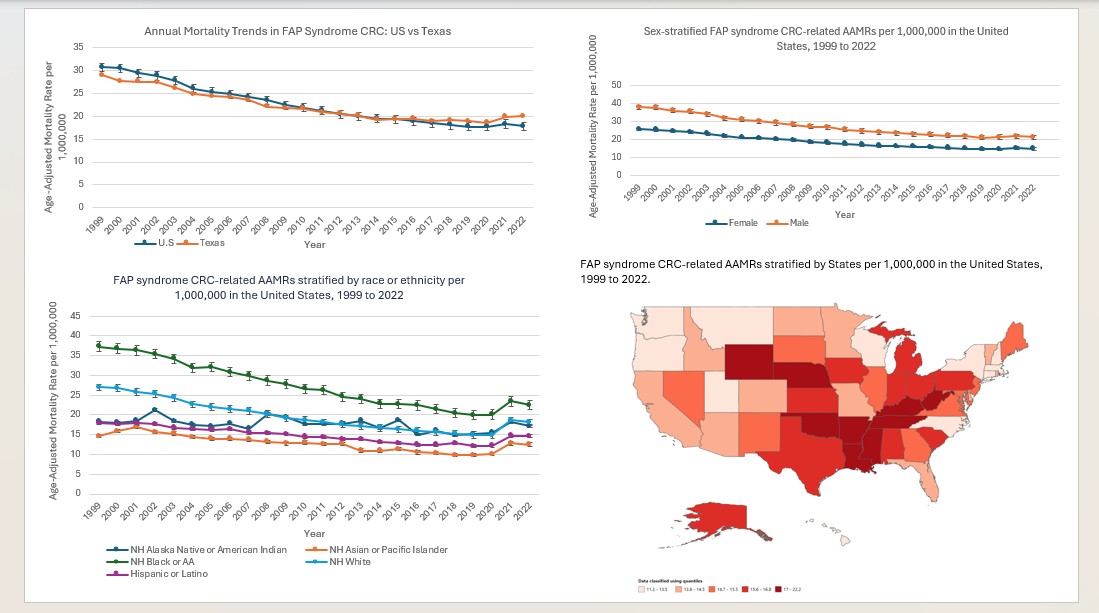Monday Poster Session
Category: Colorectal Cancer Prevention
P2654 - Trends in Mortality and Racial Disparities in Familial Adenomatous Polyposis-Associated Colorectal Cancer: A 23-Year Analysis (1999–2022): A CDC WONDER Analysis
Monday, October 27, 2025
10:30 AM - 4:00 PM PDT
Location: Exhibit Hall

Sidra Naz, MD, MPH
University of Texas MD Anderson Cancer Center
Houston, TX
Presenting Author(s)
Sidra Naz, MD, MPH1, Maitri Shah, MD2, Dharshni Ramar, MD3, Rutwik Pradeep. Sharma, MD4, Shazia Khan, MD5, Nirmit Patel, MBBS6, Choudhary Ahmed Hasan Maqbool, MD3
1University of Texas MD Anderson Cancer Center, Houston, TX; 2University of Michigan Health - Sparrow, Lansing, MI; 3University of Alabama, Heersink School of Medicine, Montgomery regional Campus, Montgomery, AL; 4University of Michigan-Sparrow Hospital, Lansing, MI; 5BronxCare Health System, New York, NY; 6St. Mary's General Hospital, New York Medical College, Denville, NJ
Introduction: Colorectal cancer (CRC) is the third most common cancer and the second leading cause of cancer death worldwide. Familial adenomatous polyposis (FAP), confers a 100% lifetime risk of CRC, making it the primary cause of mortality in this population, highlighting the need for a prevalence-based mortality study
Methods: Mortality trends for adults aged ≥ 15 years were analyzed using the CDC WONDER database, identifying deaths through ICD-10 codes C18 “Colon Malignant neoplasms” and D12 “Familial adenomatous polyposis”. Age-adjusted mortality rates per 100,000 were extracted, and annual percent changes with 95% CIs were calculated across demographic (sex, race/ethnicity, age) and geographic (state, urban-rural, regional) subgroups
Results: Between 1999 and 2022, 1,228,924 documented deaths were attributed to CRC due to FAP in the United States. The overall AAMR for FAP-related CRC mortality decreased in the US from an adjusted rate (AR) 30.7 in 1999 to 17.8 in 2022 (APC: -2.77%; 95% CI: -2.92% to -2.65%). In Texas, AAMR decreased from AR 29 in 1999 to 20 in 2022 (APC: -2.02%; 95% CI: -2.19% to -1.86%). Males had consistently higher AAMRs than females (21.3 vs. 14.9). The AAMR in US men decreased from 38.1 in 1999 to 21.3 in 2022 (APC: -2.86%; 95% CI: -2.98% to -2.77%). The AAMR in US women decreased from 25.7 in 1999 to 14.9 in 2022(APC: -2.78%; 95% CI: -2.94% to -2.65%). The non-Hispanic (NH) Black or African American (AA) population had the greatest AAMR (22.5), followed by the NH White (18.1) and NH American Indian or Alaska Native population (17.2). Lower-risk groups were the Hispanic or Latino population (14.6) and NH Asian or Pacific Islander (12.5). AAMR also varied by region (South: 16.1; Midwest: 15.6; Northeast: 14.3; West: 13.7). Non-metropolitan areas had higher AAMR (small metro: 15.2; non-core areas: 17.6; micropolitan areas: 18.9) than metropolitan areas (large central metropolitan areas: 14.2; large fringe: 13.8). The states in the upper 90th percentile were Nebraska, Louisiana, Arkansas, Wyoming, Alaska, Texas exhibited an approx. two-fold increase in AAMRs, compared to states falling in the lower 10th percentile North Carolina, Wisconsin, Washington, Utah, Oregon
Discussion: Mortality rates from Familial adenomatous polyposis-associated CRC have declined overall in the U.S. over the past two decades. NH Black or AA, NH White, and American Indian or Alaska Native men remain at high risk, emphasizing the need for further investigation regarding prevention strategies.

Figure: Annual Mortality Trends in FAP syndrome CRC-related AAMRs per 1,000,000 in the United States, 1999 to 2022
Disclosures:
Sidra Naz indicated no relevant financial relationships.
Maitri Shah indicated no relevant financial relationships.
Dharshni Ramar indicated no relevant financial relationships.
Rutwik Sharma indicated no relevant financial relationships.
Shazia Khan indicated no relevant financial relationships.
Nirmit Patel indicated no relevant financial relationships.
Choudhary Ahmed Hasan Maqbool indicated no relevant financial relationships.
Sidra Naz, MD, MPH1, Maitri Shah, MD2, Dharshni Ramar, MD3, Rutwik Pradeep. Sharma, MD4, Shazia Khan, MD5, Nirmit Patel, MBBS6, Choudhary Ahmed Hasan Maqbool, MD3. P2654 - Trends in Mortality and Racial Disparities in Familial Adenomatous Polyposis-Associated Colorectal Cancer: A 23-Year Analysis (1999–2022): A CDC WONDER Analysis, ACG 2025 Annual Scientific Meeting Abstracts. Phoenix, AZ: American College of Gastroenterology.
1University of Texas MD Anderson Cancer Center, Houston, TX; 2University of Michigan Health - Sparrow, Lansing, MI; 3University of Alabama, Heersink School of Medicine, Montgomery regional Campus, Montgomery, AL; 4University of Michigan-Sparrow Hospital, Lansing, MI; 5BronxCare Health System, New York, NY; 6St. Mary's General Hospital, New York Medical College, Denville, NJ
Introduction: Colorectal cancer (CRC) is the third most common cancer and the second leading cause of cancer death worldwide. Familial adenomatous polyposis (FAP), confers a 100% lifetime risk of CRC, making it the primary cause of mortality in this population, highlighting the need for a prevalence-based mortality study
Methods: Mortality trends for adults aged ≥ 15 years were analyzed using the CDC WONDER database, identifying deaths through ICD-10 codes C18 “Colon Malignant neoplasms” and D12 “Familial adenomatous polyposis”. Age-adjusted mortality rates per 100,000 were extracted, and annual percent changes with 95% CIs were calculated across demographic (sex, race/ethnicity, age) and geographic (state, urban-rural, regional) subgroups
Results: Between 1999 and 2022, 1,228,924 documented deaths were attributed to CRC due to FAP in the United States. The overall AAMR for FAP-related CRC mortality decreased in the US from an adjusted rate (AR) 30.7 in 1999 to 17.8 in 2022 (APC: -2.77%; 95% CI: -2.92% to -2.65%). In Texas, AAMR decreased from AR 29 in 1999 to 20 in 2022 (APC: -2.02%; 95% CI: -2.19% to -1.86%). Males had consistently higher AAMRs than females (21.3 vs. 14.9). The AAMR in US men decreased from 38.1 in 1999 to 21.3 in 2022 (APC: -2.86%; 95% CI: -2.98% to -2.77%). The AAMR in US women decreased from 25.7 in 1999 to 14.9 in 2022(APC: -2.78%; 95% CI: -2.94% to -2.65%). The non-Hispanic (NH) Black or African American (AA) population had the greatest AAMR (22.5), followed by the NH White (18.1) and NH American Indian or Alaska Native population (17.2). Lower-risk groups were the Hispanic or Latino population (14.6) and NH Asian or Pacific Islander (12.5). AAMR also varied by region (South: 16.1; Midwest: 15.6; Northeast: 14.3; West: 13.7). Non-metropolitan areas had higher AAMR (small metro: 15.2; non-core areas: 17.6; micropolitan areas: 18.9) than metropolitan areas (large central metropolitan areas: 14.2; large fringe: 13.8). The states in the upper 90th percentile were Nebraska, Louisiana, Arkansas, Wyoming, Alaska, Texas exhibited an approx. two-fold increase in AAMRs, compared to states falling in the lower 10th percentile North Carolina, Wisconsin, Washington, Utah, Oregon
Discussion: Mortality rates from Familial adenomatous polyposis-associated CRC have declined overall in the U.S. over the past two decades. NH Black or AA, NH White, and American Indian or Alaska Native men remain at high risk, emphasizing the need for further investigation regarding prevention strategies.

Figure: Annual Mortality Trends in FAP syndrome CRC-related AAMRs per 1,000,000 in the United States, 1999 to 2022
Disclosures:
Sidra Naz indicated no relevant financial relationships.
Maitri Shah indicated no relevant financial relationships.
Dharshni Ramar indicated no relevant financial relationships.
Rutwik Sharma indicated no relevant financial relationships.
Shazia Khan indicated no relevant financial relationships.
Nirmit Patel indicated no relevant financial relationships.
Choudhary Ahmed Hasan Maqbool indicated no relevant financial relationships.
Sidra Naz, MD, MPH1, Maitri Shah, MD2, Dharshni Ramar, MD3, Rutwik Pradeep. Sharma, MD4, Shazia Khan, MD5, Nirmit Patel, MBBS6, Choudhary Ahmed Hasan Maqbool, MD3. P2654 - Trends in Mortality and Racial Disparities in Familial Adenomatous Polyposis-Associated Colorectal Cancer: A 23-Year Analysis (1999–2022): A CDC WONDER Analysis, ACG 2025 Annual Scientific Meeting Abstracts. Phoenix, AZ: American College of Gastroenterology.
